Influence of Using Tire-Derived Aggregate on the Structural Performance of Buried Concrete Pipe under Embankment Load
Abstract
1. Introduction
2. Statement of the Problem
3. The Finite Element Model
4. Material Modelling and Properties
5. Validation
6. Results
6.1. Effect of the TDA on the Development of the Bending Moment in the Pipe Wall
6.2. Perfromance of the TDA for Different Backfill Heights
6.3. Performance of the TDA for Different Diamaters
7. Conclusions
- -
- In general, it has been noticed that the TDA configuration has a remarkable influence on the performance of the TDA, where it is necessary to place the TDA layer on top of the pipe crown to enable more positive arching. Therefore, the designer should specify the configuration of the TDA for site engineers and supervise the installation to ensure that the TDA provides its best performance.
- -
- Increasing the backfill height decreases the beneficial effect of the TDA, where the percentage decrease of the maximum bending moment declines as the backfill height rises then stabilizes. Thus, the use of the TDA should be suggested for pipes buried with shallow depths.
- -
- In general, increasing the diameter of the pipe from 0.3 m to 1.2 m remarkably enhances the ability of the TDA in decreasing the maximum bending moment. However, the beneficial effect shrinks as the diameter rises further to 2.4 m. This means that the TDA could be used to increase positive soil arching, and thus, ensure economic design of buried pipes with a diameter range of 0.3 m to 1.2 m.
Author Contributions
Funding
Institutional Review Board Statement
Informed Consent Statement
Data Availability Statement
Conflicts of Interest
References
- McAffee, R.P.; Valsangkar, A.J. Field performance, centrifuge testing, and numerical modelling of an induced trench installation. Can. Geotech. J. 2008, 45, 85–101. [Google Scholar] [CrossRef]
- Kim, H.; Choi, B.; Kim, J. Reduction of earth pressure on buried pipes by EPS geofoam inclusions. Geotech. Test. J. 2010, 33, 304–313. [Google Scholar] [CrossRef]
- McGuigan, B.L.; Valsangkar, A.J. Centrifuge testing and numerical analysis of box culverts installed in induced trenches. Can. Geotech. J. 2010, 47, 147–163. [Google Scholar] [CrossRef]
- McGuigan, B.L.; Valsangkar, A.J. Earth pressures on twin positive projecting and induced trench box culverts under high embankments. Can. Geotech. J. 2011, 48, 173–185. [Google Scholar] [CrossRef]
- Vaslestad, J.; Sayd, M.S.; Johansen, T.H.; Wimen, L. Load reduction and arching on buried rigid culverts using EPS geofoam. Design metho and instrumented field tests. In Proceedings of the EPS, Lillestrom, Norway, 27 June–1 July 2011; p. 36. [Google Scholar]
- Oshati, O.S.; Valsangkar, A.J.; Schriver, A.B. Earth pressures exerted on an induced trench cast-in-place double-cell rectangular box culvert. Can. Geotech. J. 2012, 49, 1267–1284. [Google Scholar] [CrossRef]
- Bartlett, S.F.; Lingwall, B.N. Protection of pipelines and buried structures using EPS geofoam. Ground Improv. Geosynth. 2014, 547–556. [Google Scholar] [CrossRef]
- Bartlett, S.F.; Lingwall, B.N.; Vaslestad, J. Methods of protecting buried pipelines and culverts in transportation infrastructure using EPS geofoam. Geotex. Geomemb. 2015, 43, 450–461. [Google Scholar] [CrossRef]
- Witthoeft, A.F.; Kim, H. Numerical investigation of earth pressure reduction on buried pipes using EPS geofoam compressible inclusions. Geosynth. Int. 2016, 23, 287–300. [Google Scholar] [CrossRef]
- Khalaj, O.; Azizian, M.; Tafreshi, S.M.; Mašek, B. Laboratory investigation of buried pipes using geogrid and EPS geofoam block. IOP Conf. Ser. Earth Environ. Sci. 2017, 95, 022002. [Google Scholar] [CrossRef]
- Meguid, M.A.; Hussein, M.O.G. A numerical procedure for the assessment of contact pressures on buried structures overlain by EPS geofoam inclusion. Int. J. Geosynth. Ground Eng. 2017, 3, 1–14. [Google Scholar] [CrossRef]
- Meguid, M.A.; Hussein, M.G.; Ahmed, M.R.; Omeman, Z.; Whalen, J. Investigation of soil-geosynthetic-structure interaction associated with induced trench installation. Geotex. Geomemb. 2017, 45, 320–330. [Google Scholar] [CrossRef]
- Al-Naddaf, M.; Han, J.; Xu, C.; Rahmaninezhad, S.M. Effect of geofoam on vertical stress distribution on buried structures subjected to static and cyclic footing loads. J. Pipeline Syst. Eng. Pract. 2019, 10, 04018027. [Google Scholar] [CrossRef]
- Ma, Q.; Ku, Z.; Xiao, H. Model tests of earth pressure on buried rigid pipes and flexible pipes underneath expanded polystyrene (EPS). Adv. Civ. Eng. 2019, 9156129. [Google Scholar] [CrossRef]
- Khalaj, O.; Azizian, M.; Joz Darabi, N.; Moghaddas Tafreshi, S.N.; Jirková, H. The role of expanded polystyrene and geocell in enhancing the behavior of buried HDPE pipes under trench loading using numerical analyses. Geosciences 2020, 10, 251. [Google Scholar] [CrossRef]
- Akyelken, F.A.; Kılıç, H. Experimental and Numerical Analyses of Buried HDPE Pipe with Using EPS Geofoam. KSCE J. Civ. Eng. 2022, 26, 3968–3977. [Google Scholar] [CrossRef]
- McAffee, R.P.; Valsangkar, A.J. Performance of an induced trench installation. Transport. Res. Rec. 2005, 1936, 230–237. [Google Scholar] [CrossRef]
- Parker, B.A.; McAffee, R.P.; Valsangkar, A.J. Field performance and analysis of 3-m-diameter induced trench culvert under a 19.4-m soil cover. Transport. Res. Rec. 2008, 2045, 68–76. [Google Scholar] [CrossRef]
- McGuigan, B.L.; Oshati, O.S.; Parker, B.A.; Valsangkar, A.J. Post-construction performance of induced trench rigid culverts. Can. Geotech. J. 2016, 53, 1807–1821. [Google Scholar] [CrossRef]
- Turan, A.; El Naggar, M.H.; Dundas, D. Investigation of induced trench method using a full scale test embankment. Geotech. Geolog. Eng. 2013, 31, 557–568. [Google Scholar] [CrossRef]
- Meguid, M.A.; Youssef, T.A. Experimental investigation of the earth pressure distribution on buried pipes backfilled with tire-derived aggregate. Transp. Geotechn. 2018, 14, 117–125. [Google Scholar] [CrossRef]
- Ni, P.; Qin, X.; Yi, Y. Numerical study of earth pressures on rigid pipes with tire-derived aggregate inclusions. Geosynth. Int. 2018, 25, 494–506. [Google Scholar] [CrossRef]
- Mahgoub, A.; El Naggar, H. Using TDA as an engineered stress-reduction fill over preexisting buried pipes. J. Pipeline Syst. Eng. Pract. 2019, 10, 04018034. [Google Scholar] [CrossRef]
- Mahgoub, A.; El Naggar, H. Coupled TDA—Geocell stress-bridging system for buried corrugated metal pipes. J. Geotech. Geoenviron. Eng. 2020, 146, 04020052. [Google Scholar] [CrossRef]
- Mahgoub, A.; El Naggar, H. Innovative application of tire-derived aggregate around corrugated steel plate culverts. J. Pipeline Syst. Eng. Pract. 2020, 11, 04020025. [Google Scholar] [CrossRef]
- Alzabeebee, S. Tire Derived Aggregate as a Sustainable Technique to Mitigate Transient Seismic Effect on Buried Concrete Pipes. Sustain. Cities Resil. 2022, 183, 317–328. [Google Scholar] [CrossRef]
- Alzabeebee, S.; Chapman, D.N.; Faramarzi, A. Development of a novel model to estimate bedding factors to ensure the economic and robust design of rigid pipes under soil loads. Tunn. Undergr. Sp. Technol. 2018, 71, 567–578. [Google Scholar] [CrossRef]
- Alzabeebee, S.; Chapman, D.N.; Faramarzi, A. Economical design of buried concrete pipes subjected to UK standard traffic loading. Proc. Inst. Civ. Eng. Struct. Build. 2019, 172, 141–156. [Google Scholar] [CrossRef]
- Umravia, N.B.; Solanki, C.H. Numerical Analysis To Study Lateral Behavior of Cement Flyash Gravel Piles Under the Soft Soil. Int. J. Eng. 2022, 35, 2111–2119. [Google Scholar] [CrossRef]
- Ali, A.H.; Abbas, H.O.; Abed-Awn, S.H. Behavior of raft foundation built on layered soil under different earthquake excitation. Int. J. Eng. 2022, 35, 1509–1515. [Google Scholar] [CrossRef]
- Zarinfar, M. Investigating the Effect of Soil Layering on Soil-structure Interaction under Seismic Load. Int. J. Eng. 2022, 35, 1989–2006. [Google Scholar] [CrossRef]
- Katona, M.G. Influence of soil models on structural performance of buried culverts. Int. J. Geomech. 2017, 17, 04016031. [Google Scholar] [CrossRef]
- Alzabeebee, S. Seismic response and design of buried concrete pipes subjected to soil loads. Tunn. Undergr. Sp. Technol. 2019, 93, 103084. [Google Scholar] [CrossRef]
- Alzabeebee, S. A comparative study of the effect of the soil constitutive model on the seismic response of buried concrete pipes. J. Pipeline Sci. Eng. 2022, 2, 87–96. [Google Scholar] [CrossRef]
- Alzabeebee, S. Seismic settlement of a strip foundation resting on a dry sand. Nat. Hazards 2020, 103, 2395–2425. [Google Scholar] [CrossRef]
- Alzabeebee, S. Influence of soil model complexity on the seismic response of shallow foundations. Geomech. Eng. 2021, 24, 193–203. [Google Scholar] [CrossRef]
- Boscardin, M.D.; Selig, E.T.; Lin, R.S.; Yang, G.R. Hyperbolic parameters for compacted soils. J. Geotech. Eng. 1990, 116, 88–104. [Google Scholar] [CrossRef]
- Simpson, Gumpertz & Heger. Appendix an Investigation of Suitable Soil Constitutive Models for 3-D Finite Element Studies of Live Load Distribution through Fills onto Culverts. Available online: http://onlinepubs.trb.org/onlinepubs/nchrp/nchrp_rpt_647appendixa.pdf (accessed on 6 October 2022).
- Bowers, J.T.; Webb, M.C.; Beaver, J.L. Soil Parameters for Design with the 3D PLAXIS Hardening Soil Model. Transport. Res. Rec. 2019, 2673, 708–713. [Google Scholar] [CrossRef]
- Thompson, M.R.; Elliott, R.P. ILLI-PAVE based response algorithms for design of conventional flexible pavements. Transport. Res. Rec. 1985, 1043, 50–57. [Google Scholar]
- Garber, N.J.; Hoel, L.A. Traffic and Highway Engineering, 4th ed.; University of Virginia, Cengage Learning: Charlottesville, VA, USA, 2009. [Google Scholar]
- Huang, Y.H. Pavement Analysis and Design; Pearson Prentice Hall: Upper Saddle River, NJ, USA, 2004. [Google Scholar]
- MacDougall, K. Behaviour and Design of Reinforced Concrete Pipes. Master’s Thesis, Queen’s University, Kingston, ON, Canada, 2014. [Google Scholar]
- Alzabeebee, S. Enhanced Design Approaches for Rigid and Flexible Buried Pipes Using Advanced Numerical Modelling. Ph.D. Thesis, University of Birmingham, Birmingham, UK, 2017. [Google Scholar]
- Alzabeebee, S.; Chapman, D.N.; Faramarzi, A. Innovative approach to determine the minimum wall thickness of flexible buried pipes. Geomech. Eng. 2018, 15, 755–767. [Google Scholar] [CrossRef]
- Liu, H.; Xiao, Y.; Liu, K.; Zhu, Y.; Zhang, P. Numerical Simulation on Backfilling of Buried Pipes Using Controlled Low Strength Materials. Appl. Sci. 2022, 12, 6901. [Google Scholar] [CrossRef]
- Kang, J. Finite element analysis for deeply buried concrete pipes in proposed imperfect trench installations with expanded polystyrene (EPS) foams. Eng. Struct. 2019, 189, 286–295. [Google Scholar] [CrossRef]
- Bosscher, P.J.; Edil, T.B.; Eldin, N.N. Construction and performance of a shredded waste tire test embankment. Transport. Res. Rec. 1992, 1345, 44–52. [Google Scholar]
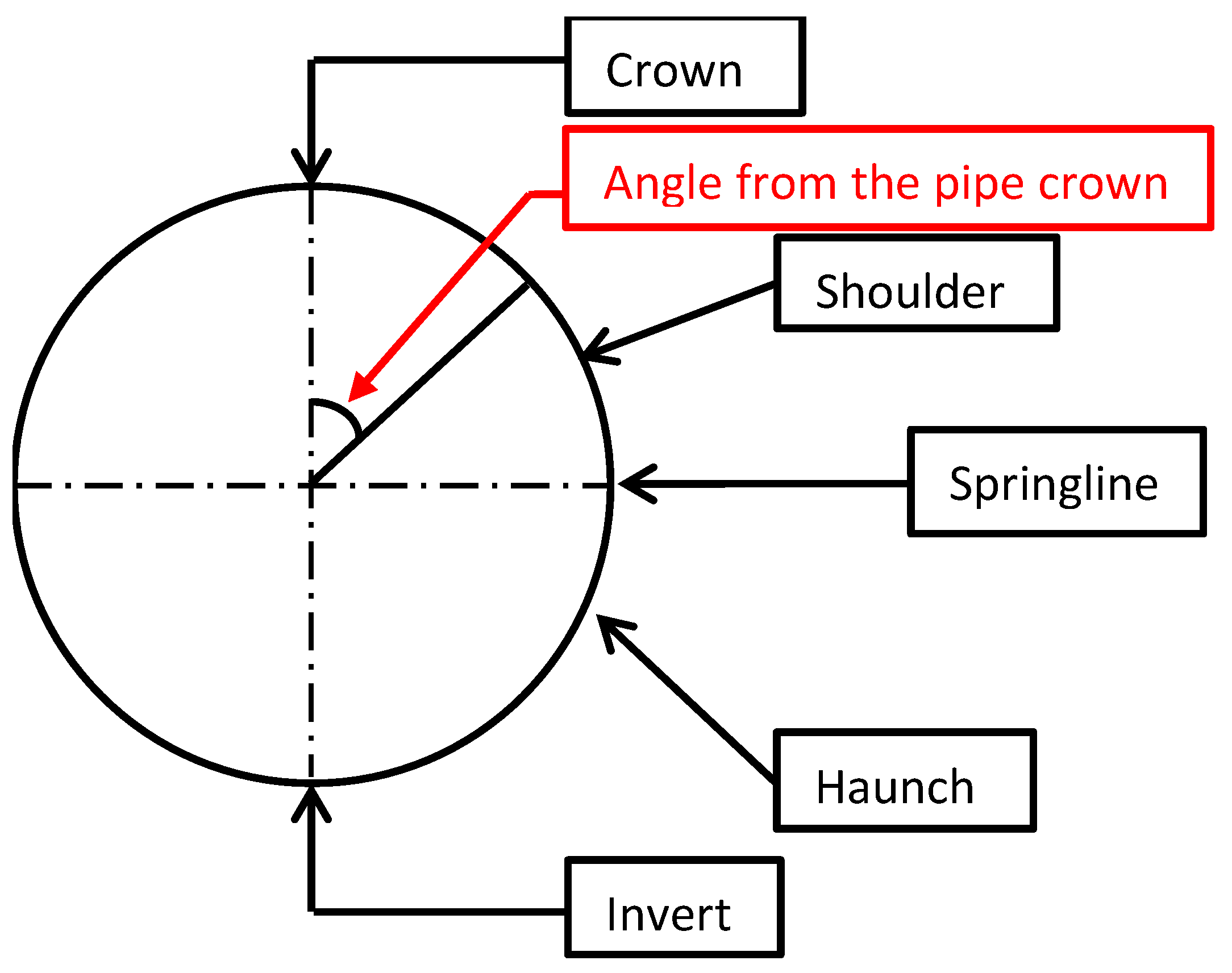
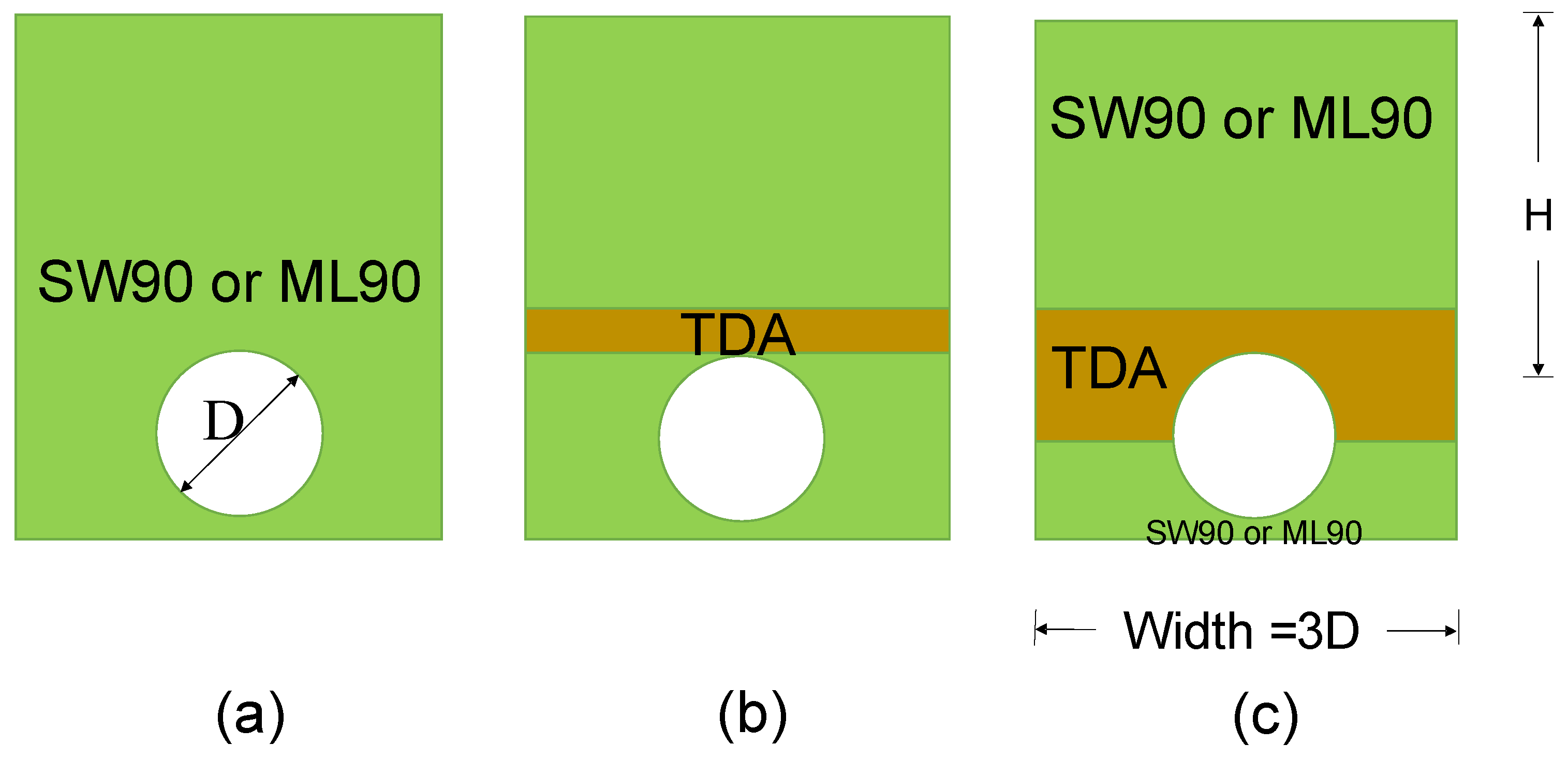

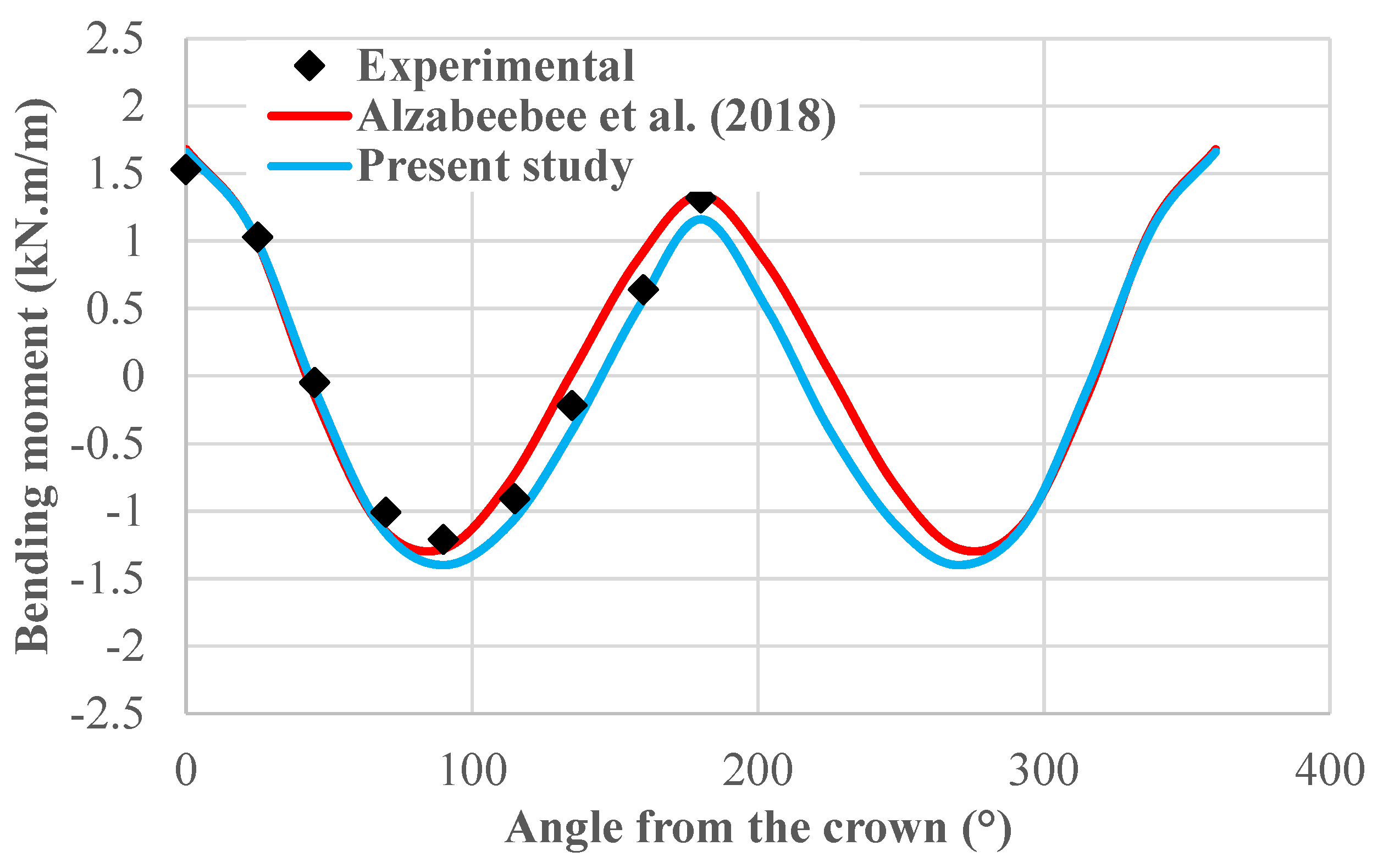
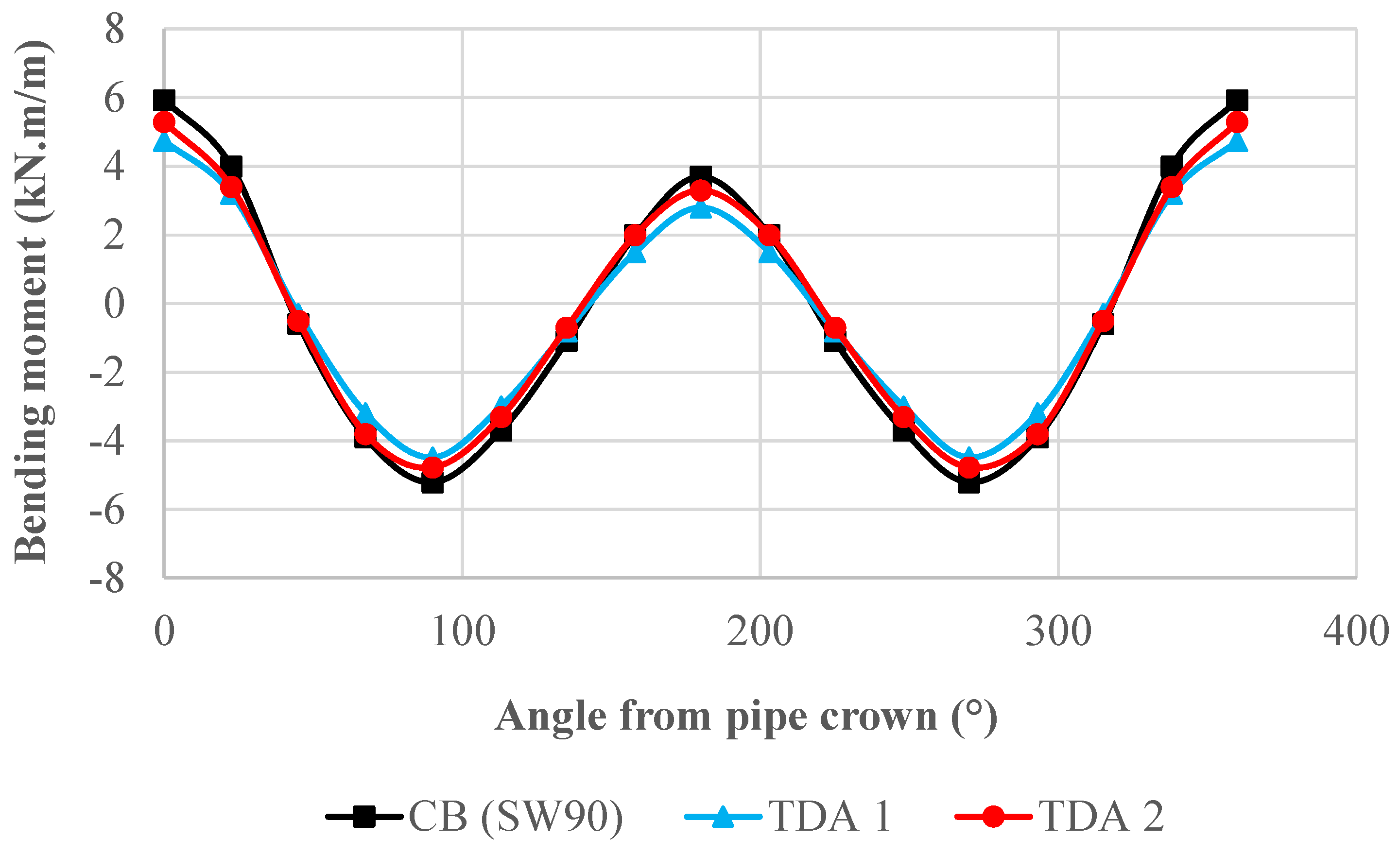
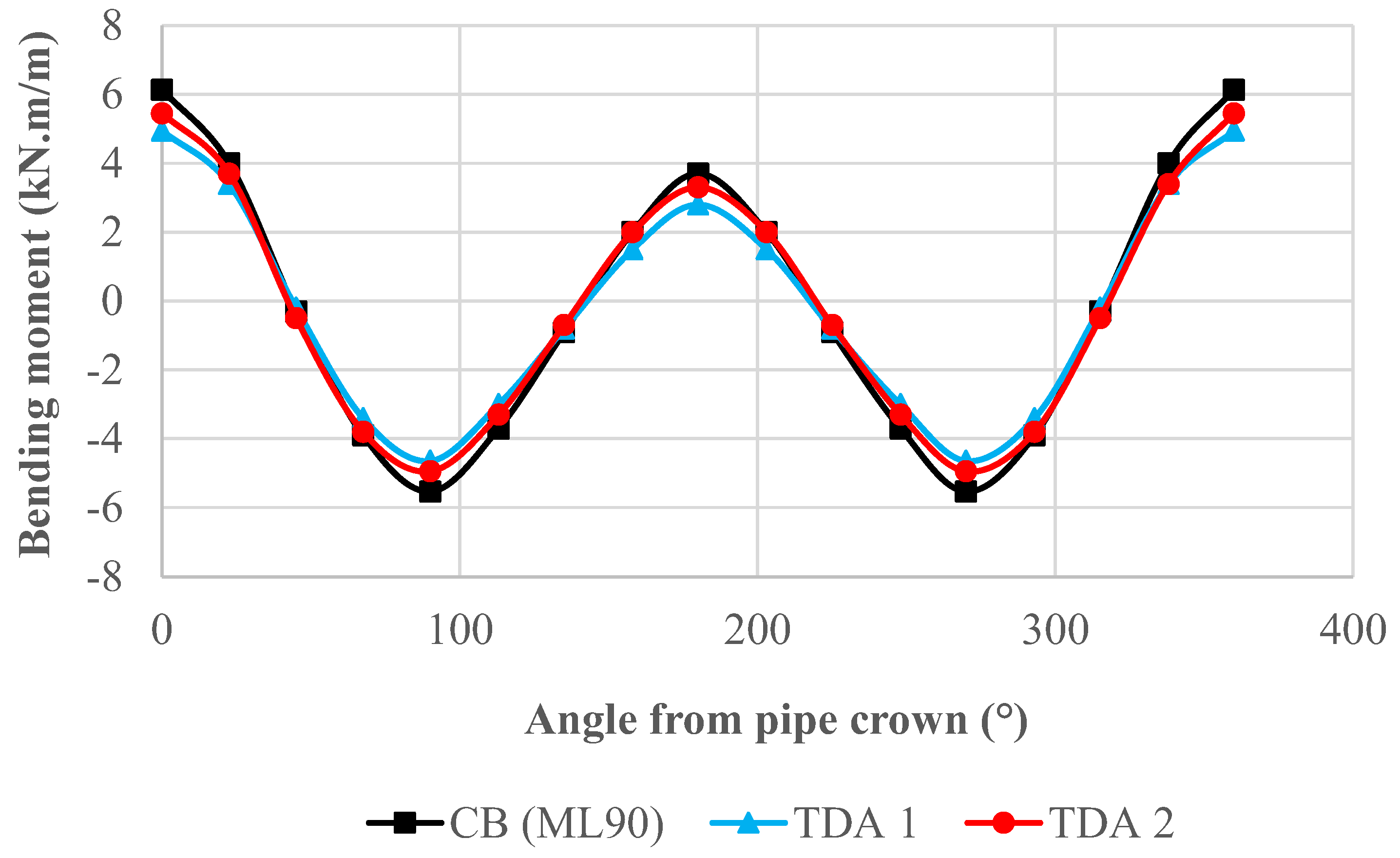

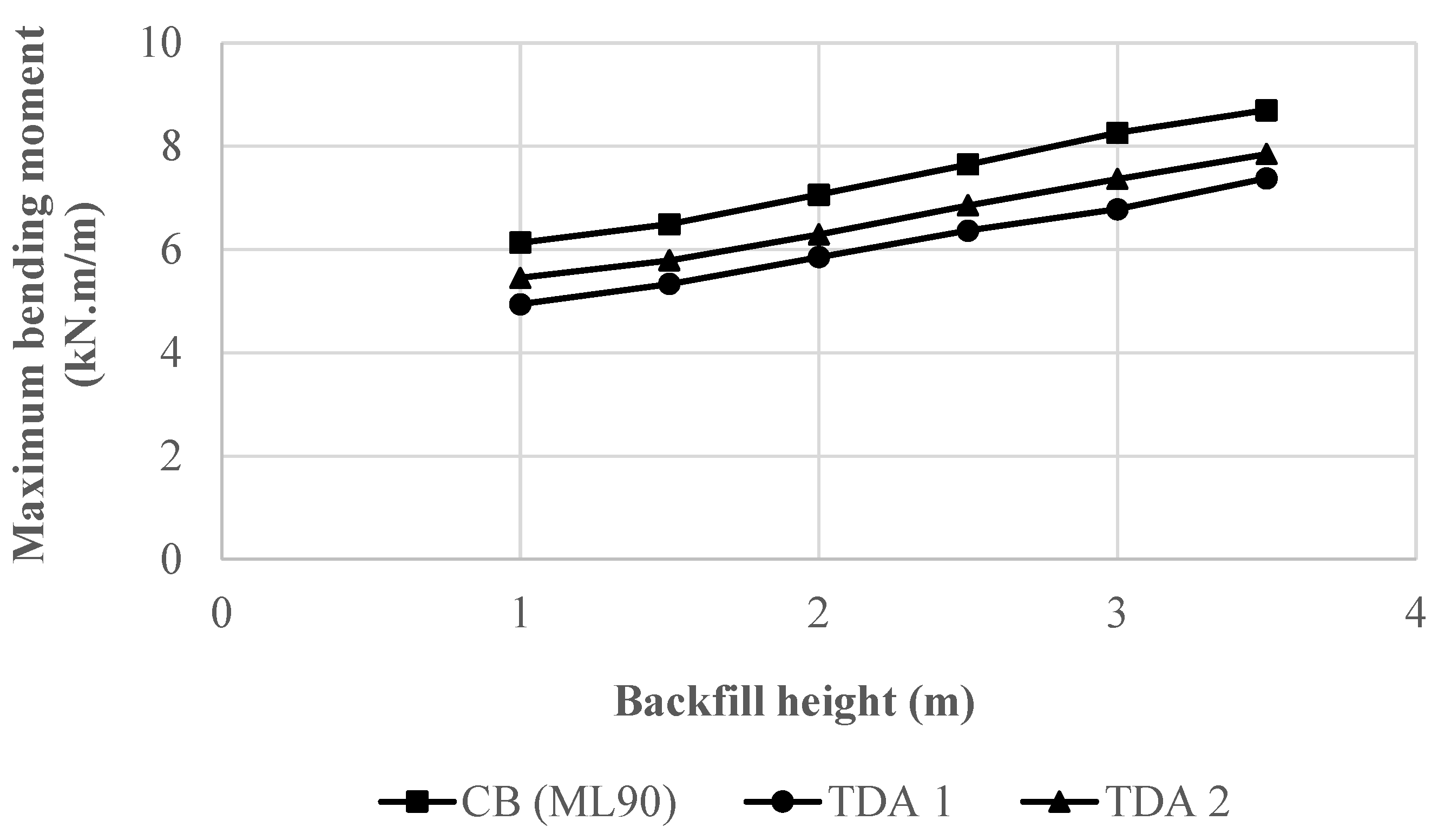
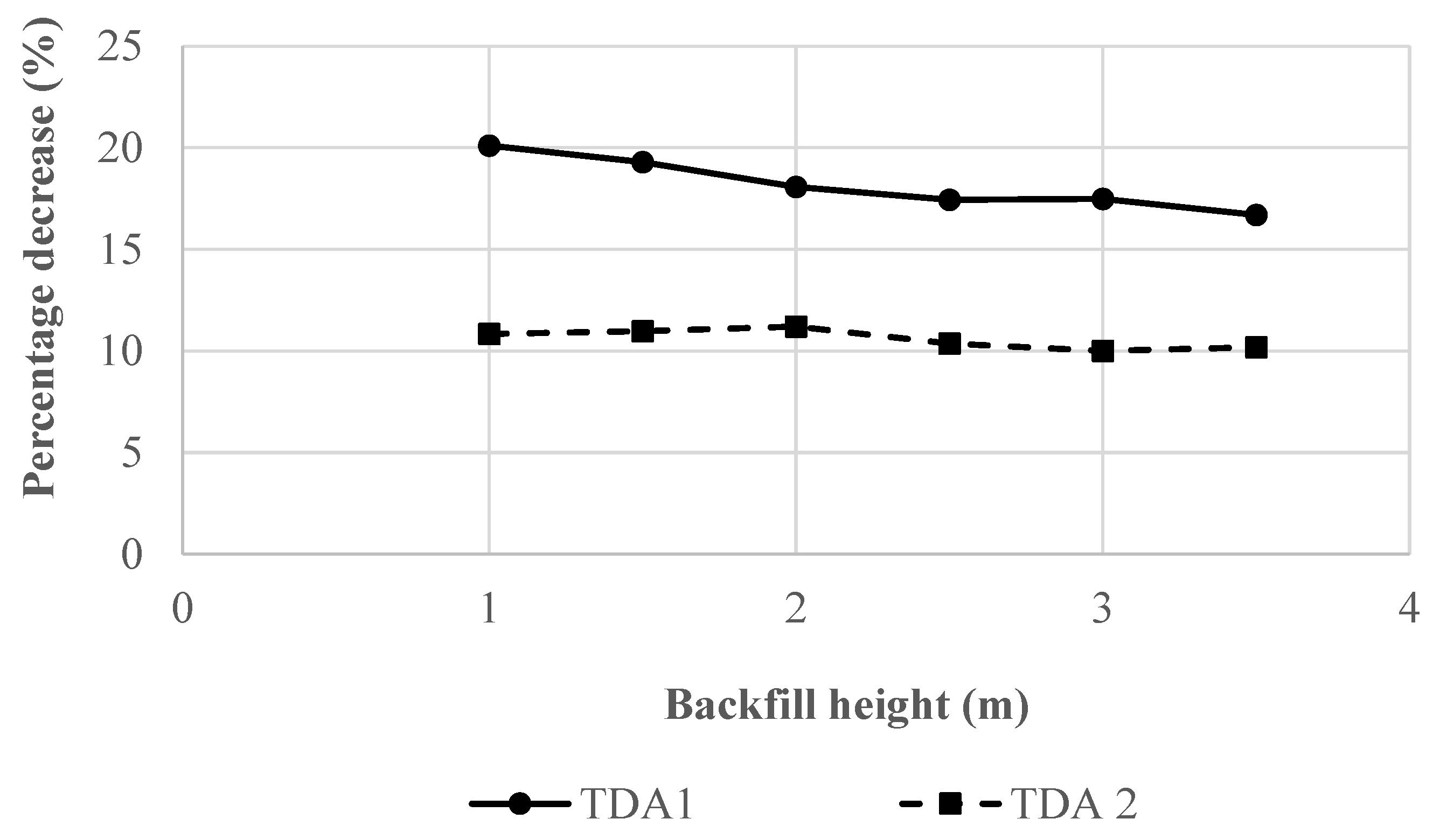
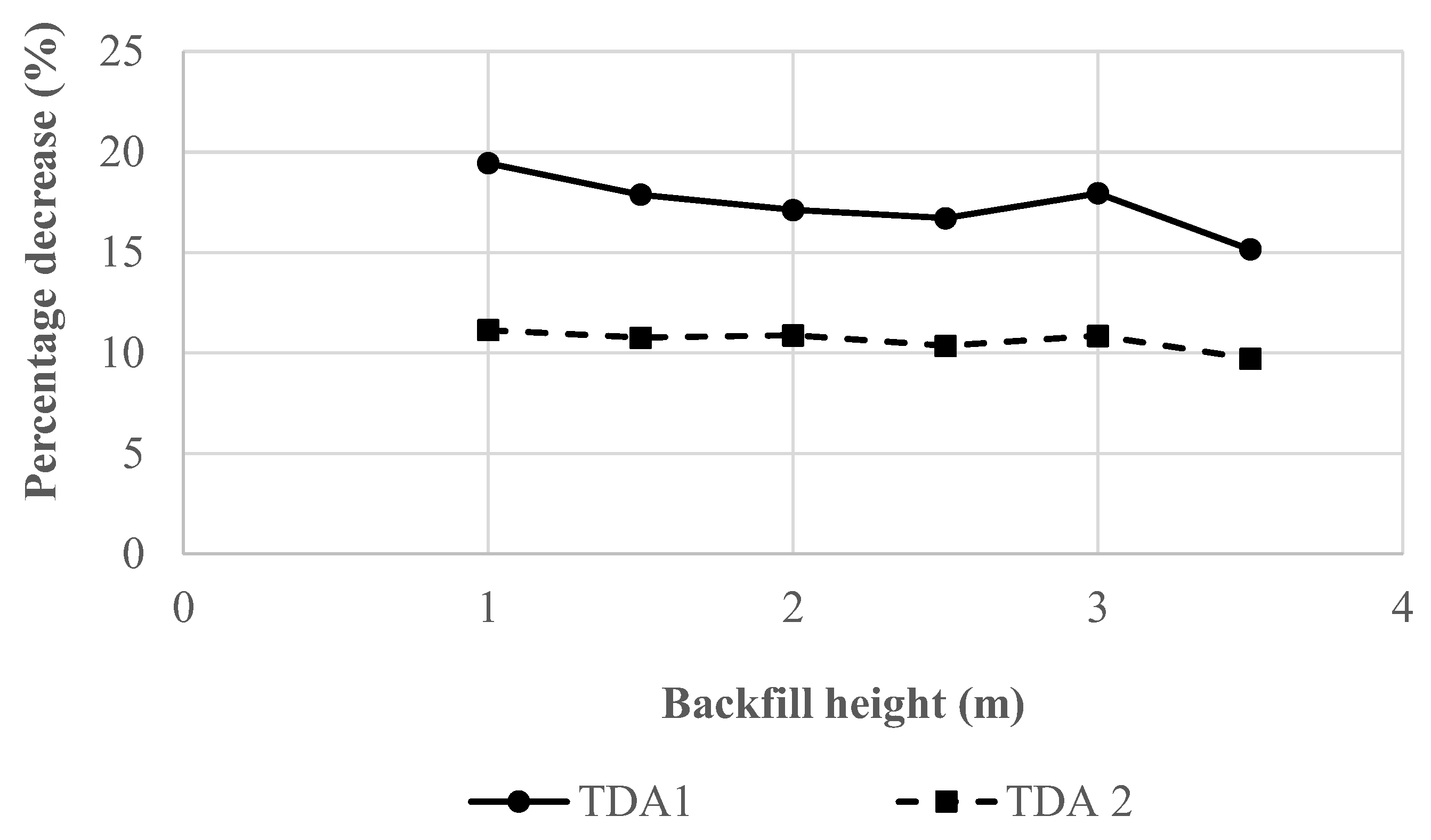



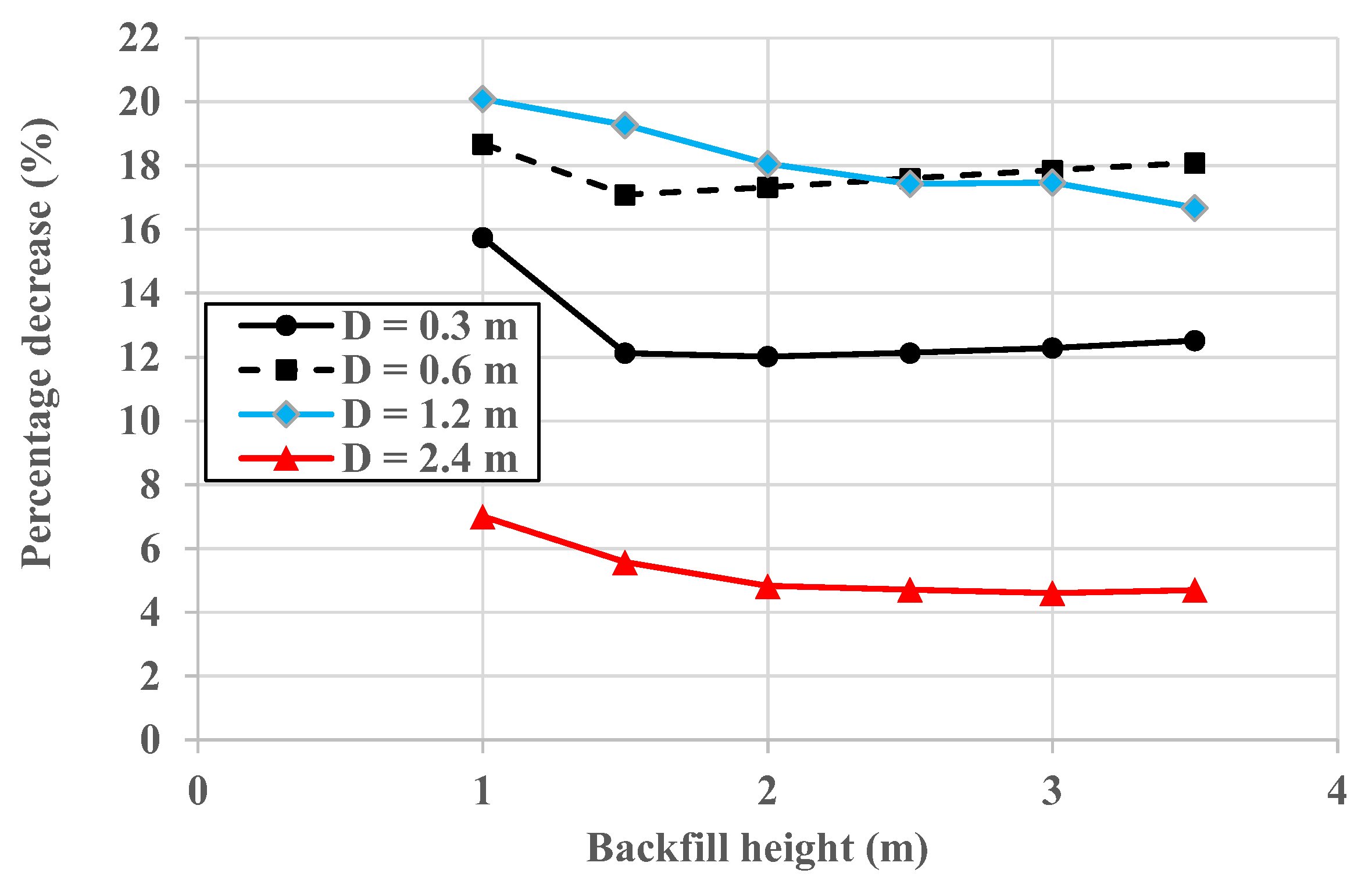
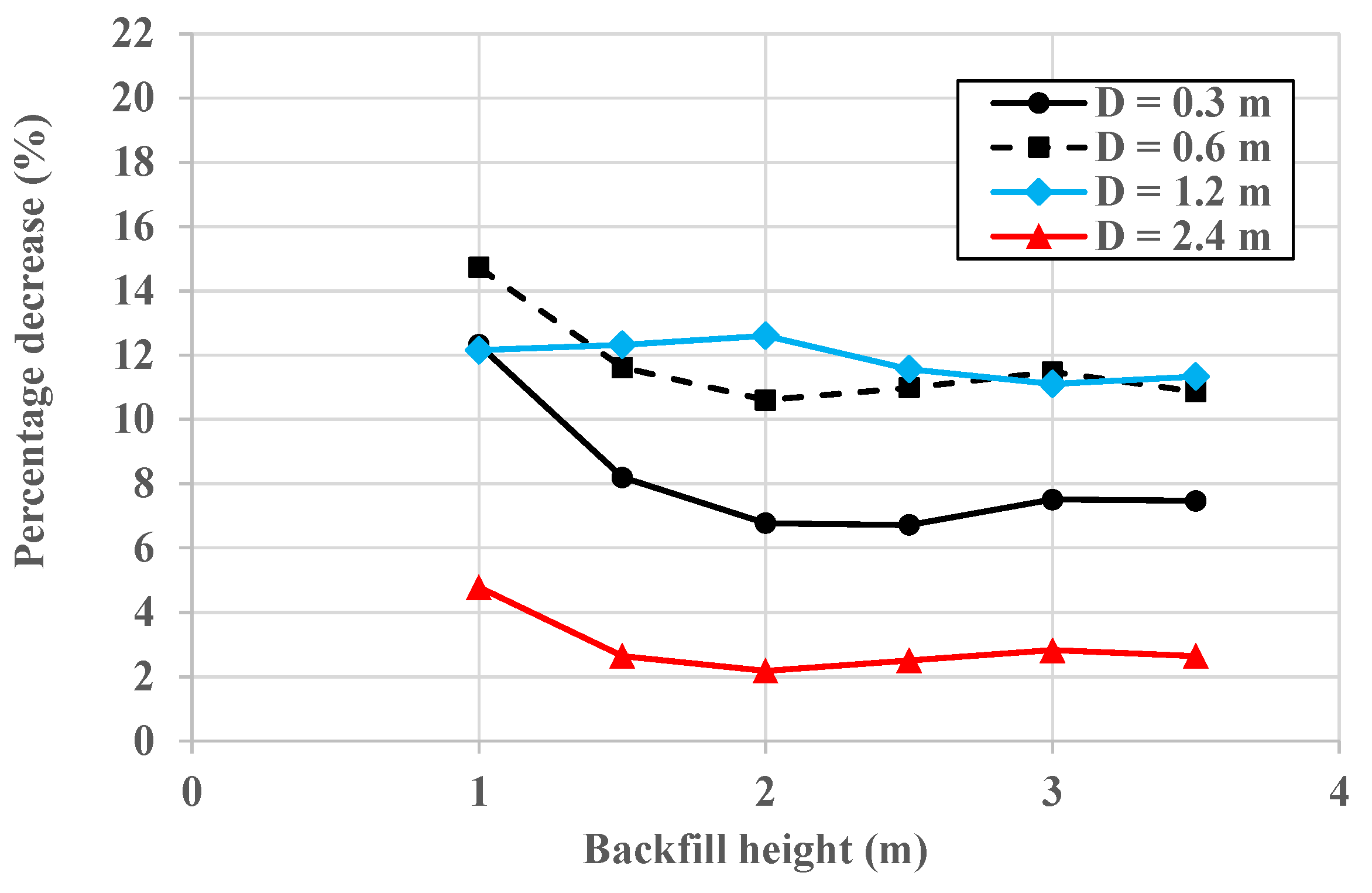
| Inside Diameter (D) (m) | Wall Thickness (m) |
|---|---|
| 0.3 | 0.055 |
| 0.6 | 0.094 |
| 1.2 | 0.144 |
| 2.4 | 0.229 |
| Parameter | SW90 | ML90 | TDA | Subgrade Soil |
|---|---|---|---|---|
| Unit weight (kN/m3) | 20.99 | 18.84 | 7 | 17 |
| Elastic modulus (MPa) | - | - | - | 31.04 |
| Poisson’s ratio | - | - | - | 0.3 |
| (Mpa) | 32.4459 | 11.26 | 2.75 | - |
| (Mpa) | 32.4459 | 5.87 | 2.2 | - |
| (Mpa) | 97.3377 | 33.77 | 8.25 | - |
| 0.2 | 0.3 | 0.2 | - | |
| (kPa) | 1 | 24 | 24 | 20 |
| (°) | 45.5 | 32.0 | 26.5 | 30.0 |
| (°) | 15.5 | 2.0 | 0.0 | 0.0 |
| 0.75 | 0.26 | 0.50 | - | |
| 0.31 | 0.43 | 0.55 | - | |
| Rf | 0.75 | 0.89 | 0.95 | - |
| (kPa) | 100 | 100 | 25 | - |
Publisher’s Note: MDPI stays neutral with regard to jurisdictional claims in published maps and institutional affiliations. |
© 2022 by the authors. Licensee MDPI, Basel, Switzerland. This article is an open access article distributed under the terms and conditions of the Creative Commons Attribution (CC BY) license (https://creativecommons.org/licenses/by/4.0/).
Share and Cite
Alzabeebee, S.; Alshibany, S.M.; Keawsawasvong, S. Influence of Using Tire-Derived Aggregate on the Structural Performance of Buried Concrete Pipe under Embankment Load. Geotechnics 2022, 2, 989-1002. https://doi.org/10.3390/geotechnics2040046
Alzabeebee S, Alshibany SM, Keawsawasvong S. Influence of Using Tire-Derived Aggregate on the Structural Performance of Buried Concrete Pipe under Embankment Load. Geotechnics. 2022; 2(4):989-1002. https://doi.org/10.3390/geotechnics2040046
Chicago/Turabian StyleAlzabeebee, Saif, Safaa Manfi Alshibany, and Suraparb Keawsawasvong. 2022. "Influence of Using Tire-Derived Aggregate on the Structural Performance of Buried Concrete Pipe under Embankment Load" Geotechnics 2, no. 4: 989-1002. https://doi.org/10.3390/geotechnics2040046
APA StyleAlzabeebee, S., Alshibany, S. M., & Keawsawasvong, S. (2022). Influence of Using Tire-Derived Aggregate on the Structural Performance of Buried Concrete Pipe under Embankment Load. Geotechnics, 2(4), 989-1002. https://doi.org/10.3390/geotechnics2040046








